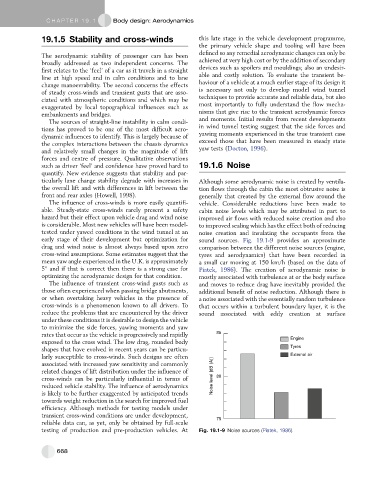Page 658 - Automotive Engineering Powertrain Chassis System and Vehicle Body
P. 658
CHAP TER 1 9. 1 Body design: Aerodynamics
19.1.5 Stability and cross-winds this late stage in the vehicle development programme,
the primary vehicle shape and tooling will have been
defined so any remedial aerodynamic changes can only be
The aerodynamic stability of passenger cars has been
broadly addressed as two independent concerns. The achieved at very high cost or by the addition of secondary
first relates to the ‘feel’ of a car as it travels in a straight devices such as spoilers and mouldings; also an undesir-
line at high speed and in calm conditions and to lane able and costly solution. To evaluate the transient be-
change manoevrability. The second concerns the effects haviour of a vehicle at a much earlier stage of its design it
of steady cross-winds and transient gusts that are asso- is necessary not only to develop model wind tunnel
ciated with atmospheric conditions and which may be techniques to provide accurate and reliable data, but also
exaggerated by local topographical influences such as most importantly to fully understand the flow mecha-
embankments and bridges. nisms that give rise to the transient aerodynamic forces
The sources of straight-line instability in calm condi- and moments. Initial results from recent developments
tions has proved to be one of the most difficult aero- in wind tunnel testing suggest that the side forces and
dynamic influences to identify. This is largely because of yawing moments experienced in the true transient case
the complex interactions between the chassis dynamics exceed those that have been measured in steady state
and relatively small changes in the magnitude of lift yaw tests (Docton, 1996).
forces and centre of pressure. Qualitative observations
such as driver ‘feel’ and confidence have proved hard to 19.1.6 Noise
quantify. New evidence suggests that stability and par-
ticularly lane change stability degrade with increases in Although some aerodynamic noise is created by ventila-
the overall lift and with differences in lift between the tion flows through the cabin the most obtrusive noise is
front and rear axles (Howell, 1998). generally that created by the external flow around the
The influence of cross-winds is more easily quantifi- vehicle. Considerable reductions have been made to
able. Steady-state cross-winds rarely present a safety cabin noise levels which may be attributed in part to
hazard but their effect upon vehicle drag and wind noise improved air flows with reduced noise creation and also
is considerable. Most new vehicles will have been model- to improved sealing which has the effect both of reducing
tested under yawed conditions in the wind tunnel at an noise creation and insulating the occupants from the
early stage of their development but optimization for sound sources. Fig. 19.1-9 provides an approximate
drag and wind noise is almost always based upon zero comparison between the different noise sources (engine,
cross-wind assumptions. Some estimates suggest that the tyres and aerodynamics) that have been recorded in
mean yaw angle experienced in the U.K. is approximately a small car moving at 150 km/h (based on the data of
5 and if that is correct then there is a strong case for Piatek, 1986). The creation of aerodynamic noise is
optimizing the aerodynamic design for that condition. mostly associated with turbulence at or the body surface
The influence of transient cross-wind gusts such as and moves to reduce drag have inevitably provided the
those often experienced when passing bridge abutments, additional benefit of noise reduction. Although there is
or when overtaking heavy vehicles in the presence of a noise associated with the essentially random turbulence
cross-winds is a phenomenon known to all drivers. To that occurs within a turbulent boundary layer, it is the
reduce the problems that are encountered by the driver sound associated with eddy creation at surface
under these conditions it is desirable to design the vehicle
to minimize the side forces, yawing moments and yaw
rates that occur as the vehicle is progressively and rapidly 85
Engine
exposed to the cross wind. The low drag, rounded body
Tyres
shapes that have evolved in recent years can be particu-
larly susceptible to cross-winds. Such designs are often External air
associated with increased yaw sensitivity and commonly
related changes of lift distribution under the influence of
cross-winds can be particularly influential in terms of Noise level [dB (A)] 80
reduced vehicle stability. The influence of aerodynamics
is likely to be further exaggerated by anticipated trends
towards weight reduction in the search for improved fuel
efficiency. Although methods for testing models under
transient cross-wind conditions are under development,
75
reliable data can, as yet, only be obtained by full-scale
testing of production and pre-production vehicles. At Fig. 19.1-9 Noise sources (Piatek, 1986).
668

